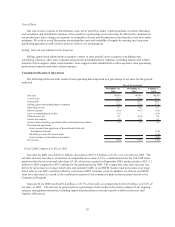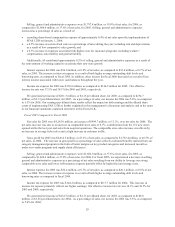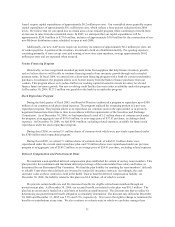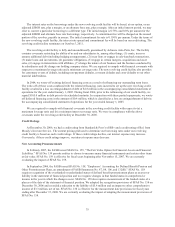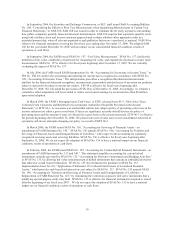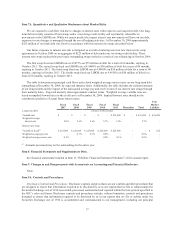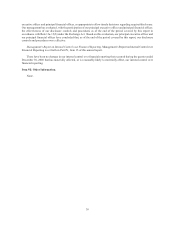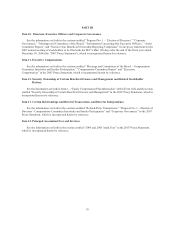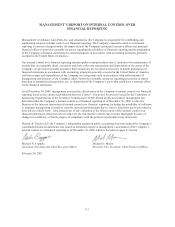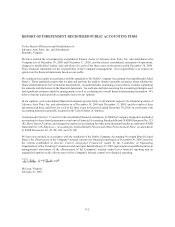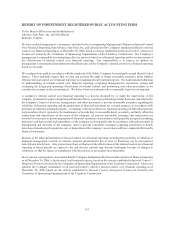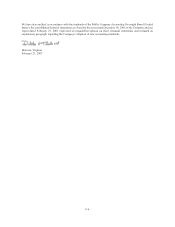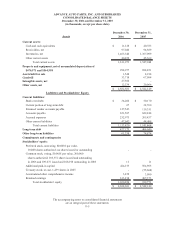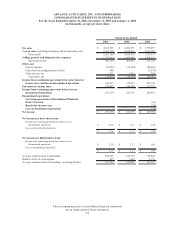Advance Auto Parts 2006 Annual Report Download - page 59
Download and view the complete annual report
Please find page 59 of the 2006 Advance Auto Parts annual report below. You can navigate through the pages in the report by either clicking on the pages listed below, or by using the keyword search tool below to find specific information within the annual report.In September 2006, the Securities and Exchange Commission, or SEC, staff issued Staff Accounting Bulletin
No. 108, “Considering the Effects of Prior Year Misstatements when Quantifying Misstatements in Current Year
Financial Statements,” or SAB 108. SAB 108 was issued in order to eliminate the diversity in practice surrounding
how public companies quantify financial statement misstatements. SAB 108 requires that registrants quantify errors
using both a balance sheet and income statement approach and evaluate whether either approach results in a
misstated amount that, when all relevant quantitative and qualitative factors are considered, is material. SAB 108 is
effective for financial statements covering the first fiscal year ending after November 15, 2006. We adopted SAB
108 for the year ended December 30, 2006 with no impact on our consolidated financial condition, results of
operations or cash flows.
In September 2006, the FASB issued SFAS No. 157, “Fair Value Measurements.” SFAS No. 157 clarifies the
definition of fair value, establishes a framework for measuring fair value, and expands the disclosures on fair value
measurements. SFAS No. 157 is effective for fiscal years beginning after November 15, 2007. We are currently
evaluating the impact of SFAS No. 157.
In July 2006, the FASB issued FASB Interpretation No. 48, “Accounting for Uncertainty in Income Taxes,” or
FIN 48. FIN 48 clarifies the accounting and reporting for income taxes recognized in accordance with SFAS No.
109, “Accounting for Income Taxes.” The interpretation prescribes a recognition threshold and measurement
attribute for the financial statement recognition, measurement, presentation and disclosure of uncertain tax positions
taken or expected to be taken in income tax returns. FIN 48 is effective for fiscal years beginning after
December 15, 2006. We will adopt the provisions of FIN 48 as of December 31, 2006. Accordingly, we estimate a
cumulative effect adjustment will be recorded to reduce our retained earnings by an amount less than $8 million
upon initial adoption.
In March 2006, the FASB’s Emerging Issues Task Force, or EITF, released Issue 06-3, “How Sales Taxes
Collected From Customers and Remitted to Governmental Authorities Should Be Presented in the Income
Statement,” or EITF 06-3. A consensus was reached that entities may adopt a policy of presenting sales taxes in the
income statement on either a gross or net basis. If taxes are significant, an entity should disclose its policy of
presenting taxes and the amount of taxes if reflected on a gross basis in the income statement. EITF 06-3 is effective
for periods beginning after December 15, 2006. We present sales net of sales taxes in our consolidated statement of
operations and do not anticipate changing our policy as a result of EITF 06-3.
In March 2006, the FASB issued SFAS No. 156, “Accounting for Servicing of Financial Assets – an
amendment of FASB Statement No. 140.” SFAS No. 156 amends SFAS No. 140, “Accounting for Transfers and
Servicing of Financial Assets and Extinguishments of Liabilities,” with respect to the accounting for separately
recognized servicing assets and servicing liabilities. SFAS No. 156 is effective for fiscal years beginning after
September 15, 2006. We do not expect the adoption of SFAS No. 156 to have a material impact on our financial
condition, results of operations or cash flows.
In February 2006, the FASB issued SFAS No. 155, “Accounting for Certain Hybrid Financial Instruments - an
amendment of FASB Statements No. 133 and 140.” This statement simplifies accounting for certain hybrid
instruments currently governed by SFAS No. 133, “Accounting for Derivative Instruments and Hedging Activities,”
or SFAS No. 133, by allowing fair value remeasurement of hybrid instruments that contain an embedded derivative
that otherwise would require bifurcation. SFAS No. 155 also eliminates the guidance in SFAS No. 133
Implementation Issue No. D1, “Application of Statement 133 to Beneficial Interests in Securitized Financial
Assets,” which provides such beneficial interests are not subject to SFAS No. 133. SFAS No. 155 amends SFAS
No. 140, “Accounting for Transfers and Servicing of Financial Assets and Extinguishments of Liabilities - a
Replacement of FASB Statement No. 125,” by eliminating the restriction on passive derivative instruments that a
qualifying special-purpose entity may hold. SFAS No. 155 is effective for financial instruments acquired or issued
after the beginning of our fiscal year 2007. We do not expect the adoption of SFAS No. 155 to have a material
impact on our financial condition, results of operations or cash flows.
36




